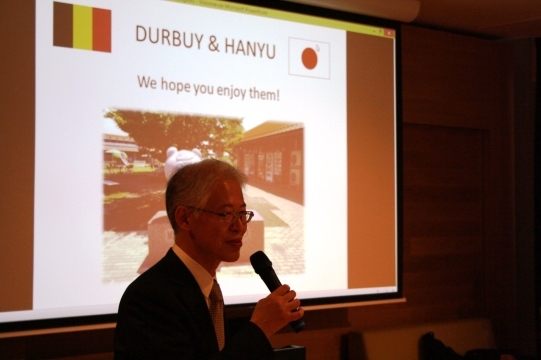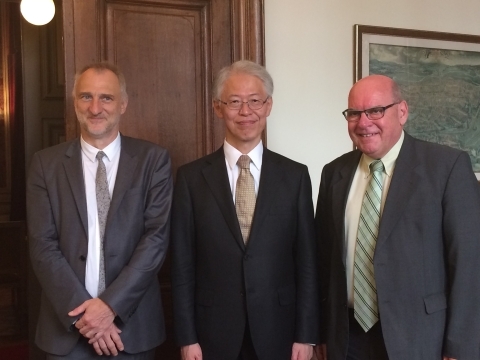Two Sister Cities’ Exchange Events (No.3)
Supporting the exchange between two countries is in the long run nothing other than people-to-people interaction. In that sense, in order to broaden and deepen the range of exchanges between Japan and Belgium, I think it is necessary to make the interaction between people of both countries even more active. There are various ways to promote people-to-people exchanges, but this time I would like to talk about the exchange between sister cities. Indeed, Japan and Belgium have eight sister cities relationships, some of which have very active interactions. In June of this year, there were two such exchange projects between sister cities of Japan and Belgium, in which the Mayors of both cities participated.
 One of them was a sister city exchange between Hanyu, located in Saitama Prefecture, and Durbuy, located in the Province of Luxembourg. In early June, a delegation from Hanyu headed by Mayor Koumei Kawata visited Durbuy. One of them was a sister city exchange between Hanyu, located in Saitama Prefecture, and Durbuy, located in the Province of Luxembourg. In early June, a delegation from Hanyu headed by Mayor Koumei Kawata visited Durbuy.
Hanyu City has long been known as a town of agriculture and indigo dyeing, making use of the rich water and fertile lands of the Tone River that flows through the north side of the city. Today it is also well-known as a manufacturing town, including its automobile parts industry. In contrast, Durbuy is a city in the valley along the Ourthe River, located in the northwest of Luxembourg Province in the Walloon Region. Durbuy once used to be one of the centers of commerce and industry in the region, but it is now known for its sightseeing and resort spots. In the center of the city, a small and lovely medieval townscape remains. Although the grounds for the claim are uncertain, it is often called "the smallest city in the world". These two cities established sister city relations in 1994, and I heard that the then Ambassador of Belgium to Japan Patrick Nothomb had a major role in the agreement. As both cities are by no means big in size, there have been factors which made it difficult to continue sister city exchanges, and there seems to have been a time when there was almost no interaction. However, due to the efforts of the people in charge on both sides, exchanges between the citizens from the two cities have continued for over 20 years, up until this very day. This time as well, the delegation that visited Durbuy was very active, organizing exchanges at the venue of the international sculpture festival in Durbuy and making plans to invite young people from Durbuy to Hanyu in the autumn of this year.
On June 1, “Durbuy & Hanyu - More than Just Sister Cities...”, an event to promote the appeal of both cities, was held at the Japan Information and Cultural Center (JICC) of the Embassy of Japan in Brussels. Representatives from both cities participated, including Mayor Kawata of Hanyu City and Deputy Mayor of Durbuy Dumoulin. The delegation of Hanyu gave a presentation about the charms of Hanyu and also explained about Hanyu’s indigo products, sake and their mascot "Mujinamon". Witnessing the delegation dedicatedly explaining in English to the Belgian participants was an impressive scene that made me realize the significance of the sister city exchanges.
 Another such sister city relation is the one between the city of Kanazawa in Ishikawa Prefecture, and the city of Ghent in the province of East-Flanders. In mid-June, Mayor of Ghent Daniel Termont and his delegation made a visit to Kanazawa. Another such sister city relation is the one between the city of Kanazawa in Ishikawa Prefecture, and the city of Ghent in the province of East-Flanders. In mid-June, Mayor of Ghent Daniel Termont and his delegation made a visit to Kanazawa.
Kanazawa is a popular city which has well guarded its historical and traditional assets dating back to the second half of the 16th century. It is an outstanding tourist destination, not only for Japanese but for visitors from abroad as well. In 2015, the Hokuriku Bullet Train line was opened up to Kanazawa, adding much to the attractiveness of this destination. On the other hand, the city of Ghent is the third largest Belgian city, after Brussels and Antwerp, and it still preserves the appearance of its former prosperous textile industry and relay trading in the Middle Ages. In addition, Ghent University is one of Belgium’s leading universities, where the Japanese language and Japanese studies are also flourishing.
Thus, Kanazawa and Ghent are cities with similar characteristics that continue to develop towards the future based on their rich history and traditions. As sister cities of Japan and Belgium, we cannot think of a possible better match. It was in 1971 that the two cities signed up as sister cities, and the exchange has now been going on for over 45 years.
In Kanazawa, there is someone active who has been dispatched from Belgium as CIR (Coordinator for International Relations) under the JET Program. Until now, Mr. Werner Vanhorenbeeck, who is from Ghent and has studied Japanese at Ghent University, supports Kanazawa's external activities, including sister city exchanges with Ghent. This summer, he will be replaced by Mr. Bert Collin, who studied Japanese at the Dutch-language Catholic University of Leuven (KUL), the largest institute for Japanese and Japanese studies in Belgium. In the future, Mr. Collin is expected to be active in further promoting exchanges between Kanazawa and Ghent.
On June 19, I visited Ghent by invitation of Mayor Termont. The Mayor had just returned from his visit to Kanazawa, and he talked with enthusiasm about the many things the two cities have in common and about the plans for future exchanges. After that, I visited Ghent University’s Department of Literature and talked with professors and students of Japanese Studies. Furthermore, I visited the Japanese "Ransho" garden, which has been donated to Ghent University by Kanazawa. It was very impressive to see the interaction between people from both Japan and Belgium actively creating a circle for the sake of the sister cities’ exchanges.
|